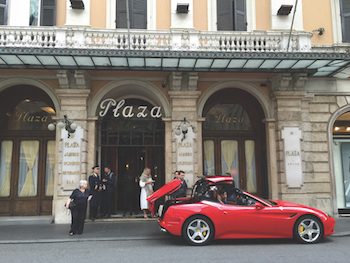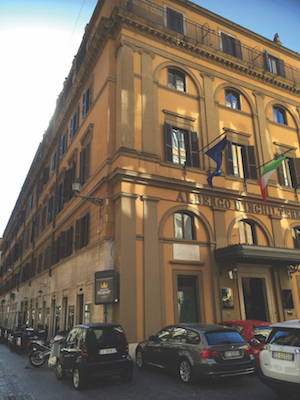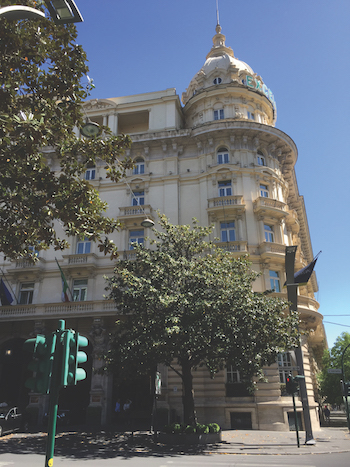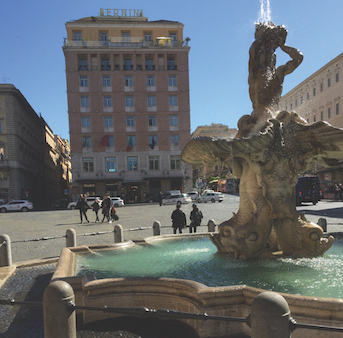There are many ways to see Rome and learn about its history, each offering a new perspective. Adrian Mourby takes us on a walk through the city, tracing its history through the development of Rome’s hotels over 600 years…
In 1855, when Cavalier Rufini took his census of Roman hotels for Pope Pius IX, he found that the city offered many small inns, some dating back to medieval times. There were an increasing number of large hotels too, including the imposing Hotel de la Minerve next to the Church of Santa Maria sopra Minerva. This had been converted from an old palazzo by a French hotelier called Joseph Sauve in 1810. It is still there today, albeit with an extra floor or two up top.
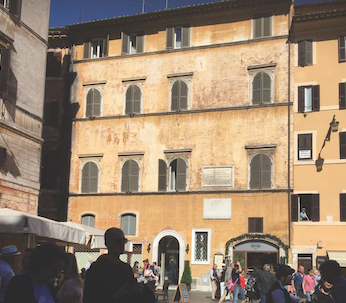 One of the earliest surviving Roman hotels is on the other side of Pantheon from the Grand Hotel de la Minerve (as it is known today). Just a three-minute walk away, the Hotel del Sole (left) looks like an ordinary townhouse facing onto the Fountain of the Pantheon. Today it is called Albergo del Sole and a plaque on the wall tells us that the poet Ludovico Ariosto (1474-1533) stayed here in 1513 when he was on a mission to the new Pope, Leo X, with whom he had dinner. It was a much warmer reception than he’d received from Leo’s predecessor, Pope Julius II who’d tried to have him killed as a representative of the troublesome Duke of Ferrara.
One of the earliest surviving Roman hotels is on the other side of Pantheon from the Grand Hotel de la Minerve (as it is known today). Just a three-minute walk away, the Hotel del Sole (left) looks like an ordinary townhouse facing onto the Fountain of the Pantheon. Today it is called Albergo del Sole and a plaque on the wall tells us that the poet Ludovico Ariosto (1474-1533) stayed here in 1513 when he was on a mission to the new Pope, Leo X, with whom he had dinner. It was a much warmer reception than he’d received from Leo’s predecessor, Pope Julius II who’d tried to have him killed as a representative of the troublesome Duke of Ferrara.
Other celebrated guests included the Holy Roman Emperor Frederick III and Count Cagliostro, a magician, alchemist and swindler who was later arrested and lived out the rest of his life imprisoned in the fortress of San Leo. After World War II, Jean-Paul Sartre and Simone de Beauvoir made this hotel their Roman home.
One source dates the hotel back to 1497, when it was called the Ram, but it is probably older still. Over the centuries it has been owned variously by the Alberini family, by a family of Turks and by the Benedictine convent of Santa Maria in Campo Marzio. On 17 May 1890 it was the temporary home of Pietro Mascagni, who celebrated the first night of Cavalleria rusticana, a piece that changed the course of Italian opera, right here in this very hotel.
Crossing the Corso and passing the Grand Hotel Plaza (which, coincidentally, was where Mascagni died in 1945) we come to Piazza del Popolo, the most dramatic and perfect of Rome’s baroque squares. Opposite Santa Maria in Montesanto, one of two almost symmetrical churches on the square, stands the Hotel de Russie, built by the urban planner and neoclassical architect Giuseppe Valadier. Valadier was responsible for the design of the whole piazza, but between 1816 and 1818 he constructed a palazzo here for Count Giovanni Torlonia, administrator of the Vatican finances.
The palazzo originally had a fine view of the whole square but that was blocked in the second half of the 19th century by new buildings. However before his new home was even finished, the count decided that he wanted to convert it into a hotel.
Piazza del Popolo was the main northern entrance into Rome and pilgrims and
tourists flooded in daily. One of these was the British artist William Turner, who in
1819 sketched work in progress on L’hôtel des Isles Britannique, as it was soon to be known. A guide published in 1833 referred to the hotel as “an excellent Inn which furnishes 150 beds”. They must have been very small bedrooms as these days with
two extra floors and two garden wings Hotel de Russie offers only 121.
Charles Dickens stayed at the hotel in 1853, arriving on 13 November and departing six days later for Florence, a coach journey that took three and a half days. Another British novelist, Wilkie Collins stayed at the hotel on 2 November 1862, complaining that Rome’s damp climate was bad for his sciatica. He was advised that the weather in Naples would suit him better and duly went in search of it, but by 4 December he was back, having not liked Naples either.
After Italian Unification in 1871 the hotel was patriotically renamed Albergo dei Rei. As its popularity grew among the Russian nobility, however, it took a new hybrid name, Hôtel de Russie et des Iles Britanniques.
By this time the enterprising Torlonia princes had created another hotel. Walk now towards the Spanish Steps and the Torlonias’ main family home, Palazzo Núñez-Torlonia on Via Bocca di Leone. Opposite it stands the Hotel d’Inghilterra. In 1845, realising that Rome was still short of hotels, Prince Giovanni opened up the family’s guest wing, an auberge opposite Palazzo Núñez-Torlonia. In order that this hotel might also attract English guests it was named Albergo d’Inghilterra (and that name is still picked out in large letters over the entrance).
In the 1880s both the Inghilterra and the Russie were managed by Francesco Nistelweck, a Munich-born hotelier (taken for Swiss in Rome – in the 19th century it
was assumed that all great hoteliers were Swiss). In 1889 Nistelwick branched out, creating a new hotel at the top of the Spanish Steps. Far from levelling off, the number of hotels being created in Rome soared towards the end of the 19th century.
The Hassler and The Eden
It is always worth climbing the Spanish Steps for the view but, when you reach the
top, do look out for Hotel Hassler. In 1889 the daughter of the Hassler family 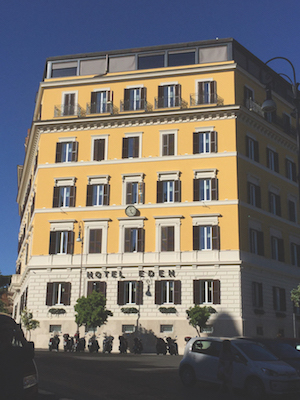 married Francesco Nistelweck and the same year they opened his new hotel together. Nistelwick’s Hotel Eden was converted out of a villa owned by Prince Piombino Boncompagni Ludovisi at one of the highest points on the Pincian Hill. The 63-bedroom hotel had superb views – and still does.
married Francesco Nistelweck and the same year they opened his new hotel together. Nistelwick’s Hotel Eden was converted out of a villa owned by Prince Piombino Boncompagni Ludovisi at one of the highest points on the Pincian Hill. The 63-bedroom hotel had superb views – and still does.
The Regina
So far on this walk, all the 19th-century hotels we’ve seen have been aristocratic homes that their owners had either sold or licensed for commercial use, but all that was about to change as a series of broad roads was built up the Pincian Hill from the new railway terminus, Roma Termini. Walk four minutes down Via Lodovisi to the broad sweep of Via Vittorio Veneto and a solid neoclassical hotel appears on the corner. Between 1892 and 1894 Cavaliere Giovanni Barbiani built his Hotel Barbiani here. The architect was Giulio Podesti, who had designed a number of 19th-century palaces in Rome. It’s perhaps not surprising that in 1910, when Queen Margherita di Savoia had to move temporarily out of the royal palace opposite, that she came to stay here for a few months. In 1911 it was decided to rename the hotel in her honour. And today it is known as the Baglioni Hotel Regina.
On the other side of Vittorio Veneto stands Excelsior, dubbed “the most Parisian hotel in Rome” when it opened in 1906. Though only a 12-year gap separates the Regina and Excelsior, the decorative styles are very different. With its great Jugendstil cupola dominating a triple-arched entrance with carvings of African, Asian, European and American caryatids, the younger hotel is dramatic and very much of the flamboyant 20th century.
Inside, all is glass and gold with lots of light blazing in from large windows. The building was designed by two Italian architects Emil Vogt and Otto Mariani and constructed for Baron Alphons von Pfyffer, a Swiss hotelier who sold it in 1920 to the Compagnia Italiana Grandi Alberghi.
While the Eden and Regina have always been discreet hotels, the Excelsior is all about money and the movies. In 1957 the hotel hosted the cast and crew of Ben-Hur and in 1960 the exterior of the Excelsior featured in La Dolce Vita with actor Lex Barker slapping Anita Ekberg across the face at the entrance (after her famous dip in the Trevi Fountain). In 1962 the hotel also featured in the Kirk Douglas film Two Weeks in Another Town, in which a washed-up actor (Douglas) takes an assignment in Rome in the hope of professional redemption. The Excelsior also featured in the 1983 Robert Mitchum WWII mini-series The Winds of War (1983), a very accurate piece of location-casting. After the fall of Rome in 1944 the Excelsior was occupied by American General Mark Clark, who had long made it his ambition to be the first Allied general into the Italian capital.
By the time the Excelsior was completed, the roads up from Termini towards the old
Aurelian Walls of Rome were pretty much filled up with hotels. One was still to reach its current form, however. Between 1939 and 1942 the Bristol, down on Piazza Barberini, was completely rebuilt to create a hotel in the Rationalist style of the Fascist era. The Bristol (now known as the Sina Bernini Bristol) originally opened in 1874 in an old palazzo that faced Bernini’s fountain of Triton. Before the First World War it provided a home for Emperor Pedro II of Brazil, Tsar Nicholas of Russia, Edward, Prince of Wales, and wealthy American families such as the Rockefellers and the Vanderbilts. The Mussolini-era makeover, however, was pretty much total, which means that the hotel does not look its age.
The Rome Cavalieri
For the next big development in Roman hotels you would have to go out beyond the Aurelian Walls and past the Vatican to Monte Mario and the splendid Rome Cavalieri, a “Hollywood on the Tiber” resort hotel inaugurated in 1963 by Conrad Hilton himself up in the hills surrounding Rome.
In the 21st century new Roman hotels have tended to be created out of existing buildings in the centre, like Portrait Roma, a series of individual suites above Salvatore Ferragamo in Via Condotti. Let’s walk back in that direction and end this tour at the new JK Place, which opened in 2013 in a 17th-century building that had been home to Rome’s School of Architecture. Tucked away behind Palazzo Borghese, this boutique hotel has interiors designed by Florentine architect Michele Bonan. The public rooms hotel have a Manhattan feel, focusing on contemporary art. Americans love it.
This walk through history has now brought us back to the centre of Rome.
JK Place Roma is just an eight-minute walk north of Albergo De Sole, where we began 600 years earlier.
Photos © Kate Tadman-Mourby 2017

